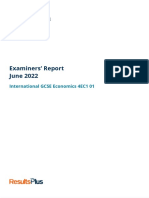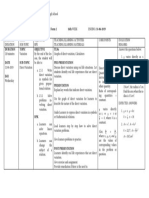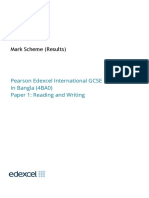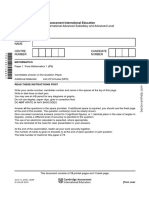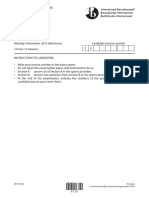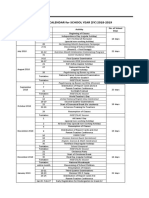Common Misconceptions
Common Misconceptions
Uploaded by
let's skip thisCopyright:
Available Formats
Common Misconceptions
Common Misconceptions
Uploaded by
let's skip thisOriginal Description:
Copyright
Available Formats
Share this document
Did you find this document useful?
Is this content inappropriate?
Copyright:
Available Formats
Common Misconceptions
Common Misconceptions
Uploaded by
let's skip thisCopyright:
Available Formats
Common misconceptions
Significant figures and decimal place rounding are often confused.
Some students may think 35 877 = 36 to two significant figures.
Src: http://www.ashtonpark.net/wp-content/uploads/2017/02/3-Year-SOW-F-9-1.pdf
Reporting proper number of significant figures
Many students do not recognize that the rules of significant figures are an efficient
means of error propagation and estimating the precision of the calculated result
based on the precision of the available data. Most textbooks do not explain the
rationale of significant figures and the connection between significant figures and
relative uncertainty. Even when confronted with this connection (via WebAssign's 1%
tolerance), a large fraction of students (~90%), and even many instructors, cannot
recognize the relative uncertainty that corresponds with the implied uncertainty in a
measured value.
Students typically report calculated values with more precision than can be justified,
but directly measured values are often reported with less precision than is possible.
Students who write down all the digits displayed on their calculator report that they
do so because they to do not want to lose any information (or grade points for an
incomplete answer). For the case of measured values, the reason for too few
significant figures comes from lack of sophistication in experimental measurement
skills.
Students also tend to give imprecise explanations when discussing sources of error.
Why this apparent inconsistency?
When an explicit uncertainty is stated, the measured value is often not properly
rounded to be consistent with the amount of uncertainty
Students often report uncertainties with too much precision (only 1 or 2 significant
figures are valid based on the fact that the uncertainty is a rough estimate that is
generally only about 50% accurate)
Src: https://users.physics.unc.edu/~deardorf/uncertainty/findings.html
They may have trouble with zeros past the decimal point or in between numbers. They may
also have trouble with zeros before the numbers (after a decimal) and after the other
numbers
Students might not know that there is a difference between accuracy and precision
Students might confuse whether they should apply the rules of addition or multiplication
with significant figures.
Src: http://kdking.weebly.com/uploads/5/4/4/7/5447198/significant_figures_lesson_plan.pdf
Students believe that calculating a number several digits after a decimal is more precise
than using significant figures
http://southwest.mpls.k12.mn.us/uploads/physics_misconceptions.pdf
You might also like
- Unit 4 Trigonometry 1Document31 pagesUnit 4 Trigonometry 1floobersdoobersNo ratings yet
- Jedec Standard: Terms, Definitions, and Letter Symbols For Microelectronic DevicesDocument119 pagesJedec Standard: Terms, Definitions, and Letter Symbols For Microelectronic Devicestruva_kissNo ratings yet
- London Examinations GCE: Mathematics Syllabus BDocument18 pagesLondon Examinations GCE: Mathematics Syllabus BAvRo Techs 360No ratings yet
- Edexcel s1 Revision NotesDocument5 pagesEdexcel s1 Revision Notesminamakin50% (2)
- Two-Way Probability Tables: WorksheetDocument3 pagesTwo-Way Probability Tables: WorksheetAmy JonesNo ratings yet
- Probability Mark Scheme: © Doublestruck & CIE - Licensed To UCSI International School 1Document4 pagesProbability Mark Scheme: © Doublestruck & CIE - Licensed To UCSI International School 1techang1100% (1)
- As Further Mathematics - CP1 - Vectors MSDocument12 pagesAs Further Mathematics - CP1 - Vectors MSjimNo ratings yet
- 4016 Mathematics Topic 1: Numbers and AlgebraDocument7 pages4016 Mathematics Topic 1: Numbers and AlgebraMohammad AshfaqNo ratings yet
- Role of The ResearcherDocument1 pageRole of The ResearcherBella Monica MontecinoNo ratings yet
- I M Here For The Hard Re Set Post Pandemic Pedagogy To Preserve Our CultureDocument12 pagesI M Here For The Hard Re Set Post Pandemic Pedagogy To Preserve Our CultureGloria Maria Naranjo Quintero100% (1)
- 3rd Grade Social Studies Visual InquiryDocument13 pages3rd Grade Social Studies Visual InquiryGabrielle DeSanoNo ratings yet
- Quiz 2 AnswerDocument9 pagesQuiz 2 AnswerFelix Llamera50% (4)
- Exploration Topic Proposal - IBDP Maths IADocument4 pagesExploration Topic Proposal - IBDP Maths IANisha KulkarniNo ratings yet
- wph15 01 Rms 20240815Document18 pageswph15 01 Rms 20240815lukelukeNo ratings yet
- GCE A Level Grading StructureDocument33 pagesGCE A Level Grading Structuremuhammadkhanpk100% (1)
- 4ec1-01-Pef-20220825 Examiners Report June22Document44 pages4ec1-01-Pef-20220825 Examiners Report June22Shibraj DebNo ratings yet
- Direct Variation Lesson NotesDocument1 pageDirect Variation Lesson Notesyaw197No ratings yet
- Maths 12-1 A Guide To Advanced TrigonometryDocument15 pagesMaths 12-1 A Guide To Advanced Trigonometryhugonunes89No ratings yet
- Cambridge O Level: Mathematics (Syllabus D) 4024/12 May/June 2021Document7 pagesCambridge O Level: Mathematics (Syllabus D) 4024/12 May/June 2021AdeenaNo ratings yet
- AQA 8464 B 1H Final MS Jun24 v1 - 0Document21 pagesAQA 8464 B 1H Final MS Jun24 v1 - 0Amos KwamenaNo ratings yet
- 9630 PH01 International As Physics Specimen Paper 2016 v2Document24 pages9630 PH01 International As Physics Specimen Paper 2016 v2Antonius Ari SudanaNo ratings yet
- 4CH1 2C Rms 20190822Document21 pages4CH1 2C Rms 20190822Åzmâñ Khäñ67% (3)
- Crossword Current Electricity CrosswordDocument3 pagesCrossword Current Electricity CrosswordGajendraNo ratings yet
- June 2023 MSDocument18 pagesJune 2023 MSSavva LazarevNo ratings yet
- A and As Level Physics Syllabus 2010Document72 pagesA and As Level Physics Syllabus 2010amachqNo ratings yet
- Cambridge IGCSE: Additional Mathematics 0606/13Document16 pagesCambridge IGCSE: Additional Mathematics 0606/13Rishwin Singh Sinda a/l Karamjeet SinghNo ratings yet
- Nov 2021 P1 MSDocument16 pagesNov 2021 P1 MSShibraj DebNo ratings yet
- 9702 w17 QP 13 PDFDocument20 pages9702 w17 QP 13 PDFDhito PramudyaNo ratings yet
- A Level Mathematics: Exam Board: EdexcelDocument10 pagesA Level Mathematics: Exam Board: EdexcelAmmaarah PatelNo ratings yet
- Word Problem Worksheet & Solutions For Rosyth Paper 2 P5 Mathematics SA2 2021Document7 pagesWord Problem Worksheet & Solutions For Rosyth Paper 2 P5 Mathematics SA2 2021memphixxNo ratings yet
- Cambridge IGCSE™: English As A Second Language 0510/21 October/November 2020Document10 pagesCambridge IGCSE™: English As A Second Language 0510/21 October/November 2020HaithamNo ratings yet
- Syllabus: Cambridge O Level Additional Mathematics 4037Document22 pagesSyllabus: Cambridge O Level Additional Mathematics 4037Sanish NoderchandNo ratings yet
- 02a IGCSE Maths 4MB1 Paper 1R - January 2020 Mark Scheme PDFDocument20 pages02a IGCSE Maths 4MB1 Paper 1R - January 2020 Mark Scheme PDFChandima PeirisNo ratings yet
- Algebra 2: Section 5.2Document20 pagesAlgebra 2: Section 5.2api-16254560No ratings yet
- Unit 1 May19 Till Jan21Document299 pagesUnit 1 May19 Till Jan21Wael TareqNo ratings yet
- wph14 01 Que 20231021Document36 pageswph14 01 Que 20231021jie714408No ratings yet
- Wma14-01-Rms-20230817 2Document23 pagesWma14-01-Rms-20230817 2Rahyan AshrafNo ratings yet
- GCE N Level Math 2009 FullDocument13 pagesGCE N Level Math 2009 FullpigamiNo ratings yet
- January 2017 (IAL) QP - S1 EdexcelDocument15 pagesJanuary 2017 (IAL) QP - S1 EdexcelWambui KahendeNo ratings yet
- Mock Exam P2Document13 pagesMock Exam P2Abin LalNo ratings yet
- Ven Diagrams WorksheetDocument8 pagesVen Diagrams WorksheetJohnnot PeagunNo ratings yet
- 4024 s02 QP 1Document16 pages4024 s02 QP 1Anas ShahzadNo ratings yet
- Ms June p1Document31 pagesMs June p1yumikoishikawaNo ratings yet
- 9709 w19 QP 12 PDFDocument20 pages9709 w19 QP 12 PDFashley poteraNo ratings yet
- 9709 s10 Ms 42Document6 pages9709 s10 Ms 42Hubbak KhanNo ratings yet
- Ial WPH05 01 Nov19 PDFDocument28 pagesIal WPH05 01 Nov19 PDFNovado San CafayreNo ratings yet
- Edexcel IAL Maths C34 Jan 2020Document48 pagesEdexcel IAL Maths C34 Jan 2020Noura TomNo ratings yet
- Q1 and Q3 Grouped DataDocument7 pagesQ1 and Q3 Grouped Datahaikal proNo ratings yet
- A5 Gold Level Model Answers IGCSE9 1 MADocument11 pagesA5 Gold Level Model Answers IGCSE9 1 MAshaNo ratings yet
- 4pm1 02 Rms 20230824Document32 pages4pm1 02 Rms 20230824waliulhasib123No ratings yet
- 2025 Specimen Paper 1Document12 pages2025 Specimen Paper 1rayirthr2010No ratings yet
- wph11 01 Pef 20230302Document22 pageswph11 01 Pef 20230302Nirmani RodrigoNo ratings yet
- Cambridge IGCSE™: Mathematics 0580/12 March 2020Document6 pagesCambridge IGCSE™: Mathematics 0580/12 March 2020Shayan NaveedNo ratings yet
- Similar TrianglesDocument17 pagesSimilar TrianglesStéphane couturier100% (5)
- Examiner Tips For O Level Additional Mathematics 4037 FINALDocument6 pagesExaminer Tips For O Level Additional Mathematics 4037 FINALAamirJavaid0% (1)
- Physics Paper 2 HLDocument29 pagesPhysics Paper 2 HLSparsh BothraNo ratings yet
- Algebraic Expression and Manipulation Notes - Mathematics D 4024 Notes - O Level AcademyDocument2 pagesAlgebraic Expression and Manipulation Notes - Mathematics D 4024 Notes - O Level AcademyNaseehaNo ratings yet
- Igcse Combined Science: Paper 0653/01 Multiple ChoiceDocument20 pagesIgcse Combined Science: Paper 0653/01 Multiple Choiceseyka4No ratings yet
- Linear Graphs, Algebra Revision Notes From GCSE Maths TutorDocument4 pagesLinear Graphs, Algebra Revision Notes From GCSE Maths Tutorgcsemathstutor100% (1)
- MF 10Document12 pagesMF 10nayagam74No ratings yet
- Maths A Level Statistics CourseworkDocument4 pagesMaths A Level Statistics Courseworkbcrs13f4100% (2)
- AP Stats Detailed SyllabusDocument16 pagesAP Stats Detailed SyllabusNaresh KumarNo ratings yet
- 1999 Comment Sta 7951 PDFDocument4 pages1999 Comment Sta 7951 PDFgwzglNo ratings yet
- Maths Statistics Coursework Mark SchemeDocument5 pagesMaths Statistics Coursework Mark Schemeafayeejka100% (2)
- Chem M13 Chemical ReactionsDocument24 pagesChem M13 Chemical Reactionslet's skip this100% (2)
- Module 6Document13 pagesModule 6let's skip thisNo ratings yet
- Module 5Document13 pagesModule 5let's skip this100% (1)
- Module 8Document14 pagesModule 8let's skip thisNo ratings yet
- Interview Consent Form: Information Sheet and Then Sign This Form To Certify That You Approve The FollowingDocument3 pagesInterview Consent Form: Information Sheet and Then Sign This Form To Certify That You Approve The Followinglet's skip thisNo ratings yet
- Science Coursework and Pedagogical Beliefs of Science Teachers: The Case of Science Teachers in The PhilippinesDocument15 pagesScience Coursework and Pedagogical Beliefs of Science Teachers: The Case of Science Teachers in The Philippineslet's skip thisNo ratings yet
- Module 1Document18 pagesModule 1let's skip thisNo ratings yet
- K12 Science Program in The Philippines: Student Perception On Its ImplementationDocument13 pagesK12 Science Program in The Philippines: Student Perception On Its Implementationlet's skip thisNo ratings yet
- Rogan (2003)Document34 pagesRogan (2003)let's skip thisNo ratings yet
- Where Does Philippine Education Go? The "K To 12" Program and Reform of Philippine Basic EducationDocument38 pagesWhere Does Philippine Education Go? The "K To 12" Program and Reform of Philippine Basic Educationaliagamps411No ratings yet
- K12 Science Program in The Philippines: Student Perception On Its ImplementationDocument13 pagesK12 Science Program in The Philippines: Student Perception On Its Implementationlet's skip thisNo ratings yet
- Interview Consent Form: Information Sheet and Then Sign This Form To Certify That You Approve The FollowingDocument3 pagesInterview Consent Form: Information Sheet and Then Sign This Form To Certify That You Approve The Followinglet's skip thisNo ratings yet
- Exploring Biotechnology-Semester 2-Grade 7 and 8Document3 pagesExploring Biotechnology-Semester 2-Grade 7 and 8let's skip thisNo ratings yet
- Gs Procurement PlanDocument25 pagesGs Procurement Planlet's skip thisNo ratings yet
- SHS General Chemistry 1Document1 pageSHS General Chemistry 1let's skip thisNo ratings yet
- Co Teaching ModelsDocument6 pagesCo Teaching Modelslet's skip this100% (1)
- Needs Assessment Survey FormDocument2 pagesNeeds Assessment Survey Formlet's skip thisNo ratings yet
- XyzDocument18 pagesXyzJasbir BooraNo ratings yet
- Simultaneous Roundtable Model of Cooperative Learning in Teaching Writing Descriptive TextDocument2 pagesSimultaneous Roundtable Model of Cooperative Learning in Teaching Writing Descriptive TextOng Kok LeongNo ratings yet
- SGS Postgraduate Application's Guide: Step 1 Choosing A ProgrammeDocument4 pagesSGS Postgraduate Application's Guide: Step 1 Choosing A ProgrammeSara OmerNo ratings yet
- Lesson Plan 7Document6 pagesLesson Plan 7api-294972418No ratings yet
- Concert Curriculum ProjectDocument11 pagesConcert Curriculum Projectapi-282839738No ratings yet
- CCE - Teachers Manual English STD 6Document32 pagesCCE - Teachers Manual English STD 6edwin_prakash75100% (1)
- Moa Concentrix 1Document6 pagesMoa Concentrix 1Dex Jamito BaflorNo ratings yet
- Calendar of Activities 2018Document2 pagesCalendar of Activities 2018Jerwin Landingin HonradoNo ratings yet
- Resume YayDocument2 pagesResume Yayapi-302050301No ratings yet
- The Audiolingual MethodDocument20 pagesThe Audiolingual MethodTatjana GlogovacNo ratings yet
- Coursework Submission Sheet: Uk Transfer Programme (Law) : : 1 2:: KL PJDocument3 pagesCoursework Submission Sheet: Uk Transfer Programme (Law) : : 1 2:: KL PJAmardev SinghNo ratings yet
- Empowerment of Barangay Peacekeeping Action Team Vis-À-Vis Peace and Order in Dapitan CityDocument9 pagesEmpowerment of Barangay Peacekeeping Action Team Vis-À-Vis Peace and Order in Dapitan CityallanNo ratings yet
- Guide For Evaluation Procedures For Employment of Consultants Under Japanese ODA Loans-200912Document44 pagesGuide For Evaluation Procedures For Employment of Consultants Under Japanese ODA Loans-200912Yamashita_KazuyoshiNo ratings yet
- CHN1 Course Outline 20 - 21Document14 pagesCHN1 Course Outline 20 - 21Edna Uneta RoblesNo ratings yet
- CNC Handbook PDFDocument241 pagesCNC Handbook PDFKhryztyan Resendiz Ramirez80% (5)
- Learning Episode 11Document18 pagesLearning Episode 11Melvin SumalinogNo ratings yet
- Evaluatorpineda Ocampoenric Demo-Teaching-Rubric FormDocument2 pagesEvaluatorpineda Ocampoenric Demo-Teaching-Rubric Formapi-711996372No ratings yet
- OVERVIEW OF Year 5 KSSR ENGLISHDocument24 pagesOVERVIEW OF Year 5 KSSR ENGLISHfatiniNo ratings yet
- Learning Style QuestionnaireDocument14 pagesLearning Style QuestionnaireAditi Ameya KirtaneNo ratings yet
- Gibney-Lorcan-G00323548-Pbl2 PosterDocument1 pageGibney-Lorcan-G00323548-Pbl2 Posterapi-400648718No ratings yet
- Scoring RubricsDocument12 pagesScoring RubricsJB JobianeNo ratings yet
- Curriculum ModelsDocument7 pagesCurriculum Modelsfreelancer_jc491% (23)
- SSC Part-I Grade - Ix: Condensed Course of Academic Year 2020-21Document22 pagesSSC Part-I Grade - Ix: Condensed Course of Academic Year 2020-21AimanNo ratings yet
- Daniel Almonacid William GoldingDocument2 pagesDaniel Almonacid William Goldingapi-282940714No ratings yet
- Sample Assignment - Summary and Connection EssayDocument3 pagesSample Assignment - Summary and Connection Essayapi-350982796No ratings yet
- Effects of Blended LearningDocument2 pagesEffects of Blended Learningalexandria quibilanNo ratings yet
- Sample Proposal 1Document30 pagesSample Proposal 1Ely Escario Jr.No ratings yet















